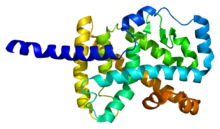RAR-srodni orfan receptor
| ||||||||||||||||||||||||||||
| ||||||||||||||||||||||||||||
| ||||||||||||||||||||||||||||
RAR-srodni orfan receptori' (ROR) su članovi familije nuklearnih receptora intracelularnih transkripcionih faktora.[1][2] Postoje tre forme ROR, ROR-α, -β, i -γ i svaki je kodiran posebnim genom (RORA, RORB, i RORC respektivno). ROR proteini us donekle neuobičajeni u tome da se oni izgleda da se vezuju kao monomeri za elemente hormonskog odgovora što je u kontrastu sa većinom drugih nuklearnih receptora koji se vezuju kao dimeri.[3]
Melatonin se smatra endogenim ligandom receptora ROR-α, dok je CGP 52608 identifikovan kao ROR-α selektivni sintetički ligand.[4] Međutim kristalografski (PDB 1n83 i 1s0x) i funkcionalni podaci sugerišu da je holesterol ili jedan of derivata holesterola mogući endogeni ligand.[5]
U kontrastu s tim, sva-trans retinoinska kiselina[6] se vezuje sa visokim afinitetom za ROR-β i -γ ali ne za ROR-α.[7]
Tri forme ROR receptora ispunjavaju brojne kritične uloge[8] uključujući:
- ROR-α - razvoj cerebeluma i limfni čvorova, lipidni metabolizam, imuno odgovor, održavanje kostiju,
- ROR-β – precizna uloga je nepoznata, mada je visoko izražen u mozgu i retini,
- ROR-γ – razvoj limfnih čvorova i imuni odgovor, opstanak T pomoćnih 17 ćelija.
- ↑ Giguère V, Tini M, Flock G, Ong E, Evans RM, Otulakowski G (1994). „Isoform-specific amino-terminal domains dictate DNA-binding properties of ROR alpha, a novel family of orphan hormone nuclear receptors”. Genes Dev. 8 (5): 538–53. DOI:10.1101/gad.8.5.538. PMID 7926749.
- ↑ Hirose T, Smith RJ, Jetten AM (1994). „ROR gamma: the third member of ROR/RZR orphan receptor subfamily that is highly expressed in skeletal muscle”. Biochem. Biophys. Res. Commun. 205 (3): 1976–83. DOI:10.1006/bbrc.1994.2902. PMID 7811290.
- ↑ Jetten AM, Kurebayashi S, Ueda E (2001). „The ROR nuclear orphan receptor subfamily: critical regulators of multiple biological processes”. Prog. Nucleic Acid Res. Mol. Biol. 69: 205–47. DOI:10.1016/S0079-6603(01)69048-2. PMID 11550795.
- ↑ Wiesenberg I, Missbach M, Kahlen JP, Schräder M, Carlberg C (1995). „Transcriptional activation of the nuclear receptor RZR alpha by the pineal gland hormone melatonin and identification of CGP 52608 as a synthetic ligand”. Nucleic Acids Res. 23 (3): 327–33. DOI:10.1093/nar/23.3.327. PMID 7885826.
- ↑ Kallen JA, Schlaeppi JM, Bitsch F, Geisse S, Geiser M, Delhon I, Fournier B (December 2002). „X-ray structure of the hRORalpha LBD at 1.63 A: structural and functional data that cholesterol or a cholesterol derivative is the natural ligand of RORalpha”. Structure 10 (12): 1697–707. DOI:10.1016/S0969-2126(02)00912-7. PMID 12467577.
- ↑ Donald Voet, Judith G. Voet (2005). Biochemistry (3 izd.). Wiley. str. 1494. ISBN 978-0-471-19350-0.
- ↑ Stehlin-Gaon C, Willmann D, Zeyer D, Sanglier S, Van Dorsselaer A, Renaud JP, Moras D, Schüle R (2003). „All-trans retinoic acid is a ligand for the orphan nuclear receptor ROR beta”. Nat. Struct. Biol. 10 (10): 820–5. DOI:10.1038/nsb979. PMID 12958591.
- ↑ Jetten AM (2004). „Recent advances in the mechanisms of action and physiological functions of the retinoid-related orphan receptors (RORs)”. Current drug targets. Inflammation and allergy 3 (4): 395–412. DOI:10.2174/1568010042634497. PMID 15584888.


